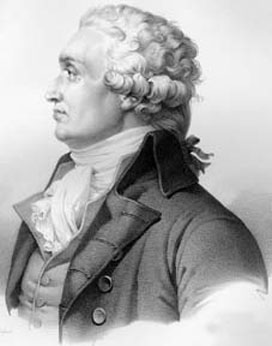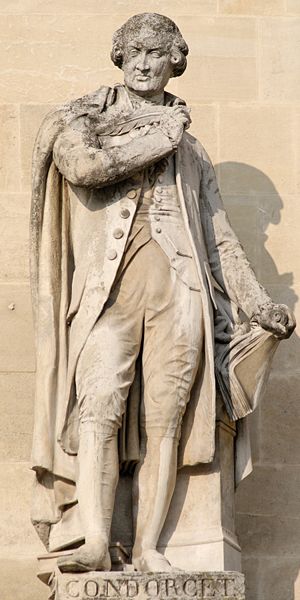<Back to Index>
- Mathematician Georg Friedrich Bernhard Riemann, 1826
- Painter Samuel Prout, 1783
- Political Scientist Marie Jean Antoine Nicolas de Caritat, Marquis de Condorcet, 1743



Marie Jean Antoine Nicolas de Caritat, marquis de Condorcet (17 September 1743 – 28 March 1794), known as Nicolas de Condorcet, was a French philosopher, mathematician, and early political scientist who devised the concept of a Condorcet method. Unlike many of his contemporaries, he advocated a liberal economy, free and equal public education, constitutionalism, and equal rights for women and people of all races. His ideas and writings were said to embody the ideals of the Age of Enlightenment and rationalism, and remain influential to this day. He died a mysterious death in prison after a period of being a fugitive from French Revolutionary authorities.
Condorcet was born in Ribemont, Aisne, and descended from the ancient family of Caritat, who took their title from the town of Condorcet in Dauphiné, of which they were long-time residents. Fatherless at a young age, he was raised by his devoutly religious mother. He was educated at the Jesuit College in Reims and at the Collège de Navarre in Paris, where he quickly showed his intellectual ability, and gained his first public distinctions in mathematics. When he was sixteen, his analytical abilities gained the praise of Jean le Rond d'Alembert and Alexis Clairault; soon, Condorcet would study under d'Alembert.
From 1765 to 1774, he focused on science. In 1765, he published his first work on mathematics entitled Essai sur le calcul intégral,
which was very well received, launching his career as a respected
mathematician. He would go on to publish many more papers, and on 25
February 1769, he was elected to the Académie royale des Sciences (French Royal Academy of Sciences). In 1772, he published another paper on integral calculus which was widely hailed as a groundbreaking paper in several domains. Soon after, he met Jacques Turgot, a French economist, and the two became friends. Turgot was to be an administrator under King Louis XV in 1772, and became Controller-General of Finance under Louis XVI in 1774. Condorcet was recognized worldwide and worked with such famous scientists as Leonhard Euler and Benjamin Franklin. He soon became an honorary member of many foreign academies and philosophic societies notably the Royal Swedish Academy of Sciences (1785), in Germany, Imperial Russia, and the United States. In 1774, Condorcet was appointed Inspector General of the Monnaie de Paris by
Turgot. From this point on, Condorcet shifted his focus from the purely
mathematical to philosophy and political matters. In the following
years, he took up the defense of human rights in general, and of women's and Blacks' rights in particular (an abolitionist, he became active in the Society of the Friends of the Blacks in
the 1780s). He supported the ideals embodied by the newly formed United
States, and proposed projects of political, administrative and economic
reforms intended to transform France. In
1776, Turgot was dismissed as Controller General. Consequently,
Condorcet submitted his resignation as Inspector General of the Monnaie, but the request was refused, and he continued serving in this post until 1791. Condorcet later wrote Vie de M. Turgot (1786), a biography which
spoke fondly of Turgot and advocated Turgot's economic theories.
Condorcet continued to receive prestigious appointments: in 1777, he
became Permanent Secretary of the Académie des Sciences, holding the post until the abolition of the Académie in 1793, and in 1782 secretary of the Académie Française. In 1785, Condorcet wrote the Essay on the Application of Analysis to the Probability of Majority Decisions, one of his most important works. This work described several now famous results, including Condorcet's jury theorem,
which states that if each member of a voting group is more likely than
not to make a correct decision, the probability that the highest vote
of the group is the correct decision increases as the number of members
of the group increases, and Condorcet's paradox, which shows that majority preferences become intransitive with
three or more options — it is possible for a majority to prefer A over B,
another majority to prefer B over C, and another majority to prefer C
over A, all from the same electorate and same set of ballots. The paper also outlines a generic Condorcet method, designed to simulate pair-wise elections between all candidates in an election. He disagreed strongly with the alternative method of aggregating preferences put forth by Jean-Charles de Borda (based on summed rankings of alternatives). Condorcet was one of the first to systematically apply mathematics in the social sciences.
In 1786, Condorcet worked on ideas for the differential and integral calculus, giving a new treatment of infinitesimals - a work which was never printed. In 1789, he published Vie de Voltaire (1789), which agreed with Voltaire in his opposition to the Church. In 1798, Thomas Malthus wrote An Essay on the Principle of Population partly in response to Condorcet's views on the "perfectibility of society". In 1781, Condorcet wrote a pamphlet, Reflections on Negro Slavery, in which he denounced slavery. Condorcet took a leading role when the French Revolution swept France in 1789, hoping for a rationalist reconstruction of society, and championed many liberal causes. As a result, in 1791 he was elected as a Paris representative in the Assemblée, and then became the secretary of the Assembly. The institution adopted
Condorcet's design for state education system, and he drafted a proposed Bourbon Constitution for the new France. He advocated women's suffrage for the new government, writing an article for Journal de la Société de 1789, and by publishing De l'admission des femmes au droit de cité ("For the Admission to the Rights of Citizenship For Women") in 1790. There were two competing views on which direction France should go, embodied by two political parties: the moderate Girondists, and the more radical Montagnards, led by Maximilien Robespierre, who favored purging France of its royal past (Ancien Régime).
Condorcet was quite independent, but still counted many friends in the
Girondist party. He presided over the Assembly as the Girondist held
the majority, until it was replaced by the National Convention, elected in order to design a new constitution. He led the Constitution Committee which drafted the Girondin constitutional project.
The constitution was ordered to be printed, but was not put to votes.
When the Montagnards gained control of the Convention, they wrote their
own, the French Constitution of 1793. At the time of King Louis XVI's trial, the Girondists had, however, lost their majority in the Convention. Condorcet, who opposed the death penalty but
still supported the trial itself, spoke out against the execution of
the King during the public vote at the Convention. From that moment on,
he was usually considered a Girondist. The Montagnards were becoming
more and more influential in the Convention as the King's "betrayal"
was confirming their theories. One of them, Marie-Jean Hérault de Seychelles, a member, like Condorcet, of the Constitution's Commission,
misrepresented many ideas from Condorcet's draft and presented what was
called a Montagnard Constitution. Condorcet criticized the new work, and as a result, he was branded a traitor. On October the 3rd, 1793, a warrant was issued for Condorcet's arrest. The
warrant forced Condorcet into hiding. He hid for five (or eight) months
in the house of Mme. Vernet, on Rue Servandoni, in Paris. It was there
that he wrote Esquisse d'un tableau historique des progrès de l'esprit humain (Sketch for a Historical Picture of the Progress of the Human Spirit),
which was published posthumously in 1795 and is considered one of the
major texts of the Enlightenment and of historical thought. It narrates
the history of civilization as one of progress in the sciences, shows
the intimate connection between scientific progress and
the development of human rights and justice, and outlines the features
of a future rational society entirely shaped by scientific knowledge. On
25 March 1794 Condorcet, convinced he was no longer safe, left his
hideout and attempted to flee Paris. Two days later he was arrested in Clamart and imprisoned in the Bourg-la-Reine (or, as it was known during the Revolution, Bourg-l'Égalité,
"Equality Borough" rather than "Queen's Borough"). Two days after that,
he was found dead in his cell. The most widely accepted theory is that
his friend, Pierre Jean George Cabanis,
gave him a poison which he eventually used. However, some historians
believe that he may have been murdered (perhaps because he was too
loved and respected to be executed). Condorcet was interred in the Panthéon in
1989, in honor of the bicentennial of the French Revolution and
Condorcet's role as a central figure in the Enlightenment. However his
coffin was empty. Interred in the common cemetery of Bourg-la-Reine, his remains were lost during the nineteenth century. In 1786 Condorcet married Sophie de Grouchy,
who was more than twenty years his junior. His wife, reckoned one of
the most beautiful women of the day, became an accomplished salon hostess as Madame de Condorcet, and also an accomplished translator of Thomas Paine and Adam Smith.
She was erudite, intelligent, and well-educated, fluent in both English
and Italian. The marriage was a strong one, and Sophie visited her
husband regularly while he remained in hiding. Although she began
proceedings for divorce in January 1794, it was at the insistence of
Condorcet and Cabanis, who wished to protect their property from
expropriation and to provide financially for Sophie and their young
child, a daughter Louise Alexandrine, known as Eliza, who had been born
in 1790. Condorcet
was survived by his widow and their four-year-old daughter Eliza.
Sophie died in 1822, never having remarried, and having published all
her husband's works between 1801 and 1804. Her work was carried on by
their daughter Eliza Condorcet-O'Connor, wife of former United Irishman Arthur O'Connor. The Condorcet-O'Connors brought out a revised edition between 1847 and 1849.